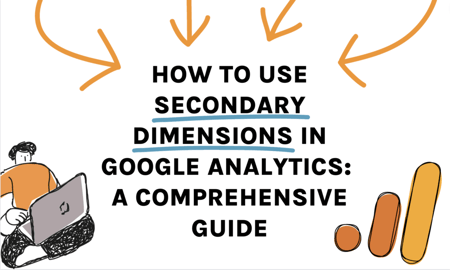Maximizing SEO Efficiency with Secondary Dimensions: Best Practices
Maximizing SEO Efficiency with Secondary Dimensions: Best Practices
Blog Article
Enhance Your Data Analysis Utilizing Secondary Dimensions
The real depth of understandings lies in the assimilation of second dimensions. The tactical usage of additional measurements raises evaluation past the surface area level, assuring a wealth of untapped prospective waiting to be uncovered.
Understanding Additional Dimensions
Secondary measurements in information analysis refer to added attributes or metrics that provide deeper understandings when combined with primary data dimensions, improving the total understanding of the dataset. These added measurements use a more extensive view of the information, allowing experts to reveal covert patterns, partnerships, and fads that might not appear when just thinking about main dimensions.
By incorporating second measurements right into data evaluation, analysts can acquire an extra nuanced understanding of the aspects influencing the key metrics. In advertising analysis, primary dimensions could consist of fundamental customer demographics like age and sex, while second measurements can incorporate variables such as acquiring habits, choices, or geographic place. By combining these second and primary measurements, analysts can produce more thorough consumer accounts, allowing more targeted and effective advertising and marketing methods.
Furthermore, additional measurements can assist in identifying relationships between various variables, leading to even more precise predictive modeling and decision-making. They make it possible for experts to check out information from multiple point of views, improving the understandings drawn from the dataset and inevitably enhancing the top quality of analysis and critical recommendations.
Benefits of Second Measurements
When considering data analysis, integrating secondary measurements provides a plethora of advantages that dramatically boost the deepness and breadth of understandings obtained from main information measurements. By including additional dimensions such as time, area, or demographic info to the evaluation, scientists can get a more detailed understanding of the key data points.
Moreover, second dimensions can likewise help in segmenting data, permitting a more thorough analysis of specific parts within the key information. This division can result in more targeted methods and activities based upon the one-of-a-kind characteristics of each sector. In addition, additional measurements can help in confirming searchings for from key information dimensions, offering a more durable and reliable basis for decision-making.
Essentially, the advantages of integrating second measurements right into data analysis are very useful, supplying richer insights and allowing even more enlightened decision-making procedures.
Implementing Additional Dimensions Effectively
Reliable execution of additional dimensions in information evaluation needs a tactical method that maximizes the utility of additional contextual details. When including additional dimensions, it is vital to straighten them with the primary measurements to get deeper understandings right into the data. Begin by plainly defining the purposes of the evaluation to determine which second dimensions will supply the most relevant context. It is crucial to choose second dimensions find out that complement the primary data without causing noise or confusion in the analysis.
In addition, think about the scalability of the second measurements throughout various datasets or evaluations. Guarantee that the selected secondary measurements can be consistently applied and translated throughout various circumstances to preserve the honesty and consistency of the evaluation. Additionally, develop an organized process for integrating additional measurements into the analysis workflow to streamline the analysis of outcomes. By executing secondary measurements successfully, analysts can enhance the depth and accuracy of their data analysis, bring about even more educated decision-making and actionable insights.
Advanced Techniques With Additional Dimensions
For a more innovative strategy to data analysis, including second measurements can substantially elevate the depth of understandings acquired. Advanced strategies with secondary dimensions involve more complex approaches to extract valuable information from data sets. One such strategy is cohort analysis, where data is fractional based upon particular features or behaviors to track patterns in time. This method enables a much deeper understanding of how different groups progress and interact with your product or solution.
Another advanced method is regression evaluation, which assists identify relationships in between variables and how they affect each various other. By adding additional dimensions, such as demographic info or individual actions, to regression designs, you can uncover much more nuanced insights and make more exact forecasts.

Case Studies: Additional Measurements in Activity

In one more situation, a medical care provider leveraged secondary dimensions to optimize source allotment. By assessing person results in connection with geographical place, the organization recognized locations with high readmission rates. This caused the implementation of targeted treatment programs in those regions, eventually boosting client care and Our site decreasing medical care prices.
These study show the power of second measurements in discovering important insights that drive critical decision-making. By diving deeper into information analysis beyond main metrics, companies can obtain a much more comprehensive understanding of their operations and consumers, causing more enlightened and efficient service techniques.
Final Thought
In conclusion, the incorporation of additional measurements in data analysis is essential for getting a detailed understanding of underlying patterns and elements. By making use of methods such as friend analysis and regression analysis, companies can reveal hidden understandings and make even more informed choices. Second dimensions add deepness and breadth to information evaluation, allowing companies to check out information from multiple viewpoints and drive much more efficient end results.
In marketing analysis, key measurements could consist of standard customer demographics like age and gender, while additional dimensions might incorporate variables such as acquiring habits, choices, or geographic place.When taking into consideration information evaluation, including secondary measurements provides a plethora of benefits that considerably improve the depth and breadth of insights obtained from key information dimensions.In addition, additional dimensions can likewise help in segmenting information, enabling for an extra detailed analysis of particular subsets within the key information. Furthermore, second dimensions can aid in confirming findings from primary data measurements, giving a much more reputable and durable basis for decision-making.
When integrating secondary dimensions, click here to read it is important to straighten them with the key dimensions to obtain much deeper understandings into the information.
Report this page